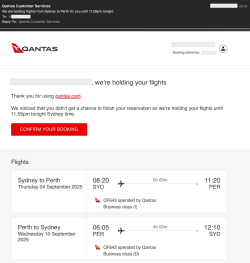RichardMEL
Enthusiast
- Joined
- Mar 28, 2014
- Posts
- 10,087
- Qantas
- Platinum 1
OK, I don't really want to get into a bid discussion of the whole deal of fares, booking classes, inventory etc and how that all fits in together because that's a little off scope here, but in relation to your questions:View attachment 375373
When looking at the Qantas website you only have one option in each class but price may vary depending on availability, presumably hence the different letter. Is that what the letters mean? But do I get the same service whichever in each class I'm on? Is this something for Qantas bookkeeping? I will get the same points and SCs whatever the letter.
Basically yes. Both to about the pricing and inventory (based on booking codes, tied to fare price points more or less) is what the different letters mean in relation to QF's "fare categories" or groupings, and yes you'd get the same SC and points for each fare category no matter the fare class (letter) being used*.
What QF is doing, as most airlines do, is basically saying "We're offering you the lowest price available for this category of fares" - Discount, Flex etc. If you look at a typical route you'll often see differences in pricing within a day such that the discount fares will have cheaper options and more expensive depending on time of deay, demand etc - but generally the same benefits accrue whichever price one picks. The flex fares will often show as the same, but in some cases you may see a more expensive flex fare show for a heavily booked flights if the cheaper flex fares (eg: K) are already not available.
I am only writing very simply about this. Someone like @madrooster may have conniptions reading this - apologies - but trying to get the (uh) point across as simply as possible.
In general, the booking classes (eg: Y M B H K L V Q N O etc ) go in order from highest to lowest in value. In a straight market for a flight, eg: MEL-SYD, then that is the way the fare pricing will go, and depending on yield management, various fares will be made available, or not, depending on the mix determined for max yield for each particular flight. So, let's say to be simplistic, and "O" fare - pretty cheap - is set at say $99, a Q fare at $109, a V fare of $119, a L fare of $159 a K fare of $199, a H fare of $399 and say Y of $599 - and no, these are not close to reality - just hypothetical example - a particular flight will have a certain mix of the cheaper $99 fares available, but they'd prefer to sell far more of your say $119's let alone $199 or $399 fares - so these are always made more available to purchase, Say a flight has 10 of these cheap O fares out, if they get snapped up, it may jump to the next available fare type, which I've made up to be $119. Fares keep selling until basically the flight is full more or less (with YM making adjustments depending on hos actual bookings are going of course, so one may see cheaper fares opened up at some point).
That's just one flight though. These things also come into play with connections and much larger fare types and itins, eg that MEL-SYD as part of MEL-SYD-HKG, or MEL-SYD as part of a RTW. The airline will price and "show" availability for the same flight differently depending on what they are willing to sell for the bigger Oirigin & Destination (O&D) eg, they ma not want to sell cheaper O fares for MEL-HKG, even if MEL-SYD and SYD-HKG both have O seats available, so then you get pushed into the higher fare class based on that. For things like RTW tickets, they can book into very specific inventory buckets (iirc the oneworld RTW fares used to book into L for ecnomy) and that's something else totally in terms of how that works, but it is still a way of controlling availibility on both individual and connecting sectors.
Remembering also that under the GDS's, there can be literally hundreds of fares and things that can work on any particular flight - so it is not a simple thing. Many can be market centric too, with specific differences depending on poin of sale for example (for example, does one want to be able to offer cheaper inbound tourism fares from certain places vs the outbound?)
And, there can often be a number of fares linked to each "availability bucket" (ie letter). It's not 1:1 at all. They can each have slightly different application too.
I've probably written way too much on the topic here - i find this kind of thing really interesting personally and love that side of the system in how it works. In another life I may have gone into revenue management or something, but I'm not
Anyway the fare codes/buckets/inventory letters have multiple meanings and uses is I guess the point but most of this should be transparent to the general passenger. Only nerds like me care about such things, and people looking for things like working out earn of course.
(* for partners, this is not always the case as many well know, for example some discount fare types for partners may earn differing levels on that partner's program and this is in general why a lot of people care about the "fare bucket" being used. For example, for an AA member booking discounted economy flights, they earn only 50% base miles for flights booked in H K L M V - and yes, some of those are flex! - and 25% for S N G O Q) - while all those fares under QFF will earn full within QFF.)
Last edited:
















